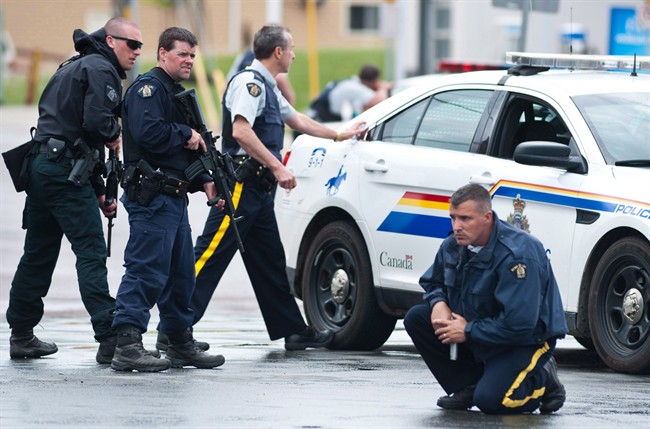An expert in tactical operations said emergency response teams were “confused” when they arrived on the scene of a 2014 shooting rampage in Moncton, N.B., and did not feel they had the appropriate firearms for the situation.

Testifying at the RCMP’s Labour Code trial Tuesday, Staff Sgt. David Lowry said the information emergency response teams had was that the active shooter was indoors.
Lowry, who conducted an interview as part of an independent review of the incident, said response team members would have picked different firearms if they had the correct information.
“Because of the reality of the events on the ground, where the subject was out in the open in an open environment, the MP5 firearm they brought with them would not have been deemed the appropriate tactical choice,” he said.
READ MORE: Injured Mountie recalls gunman casually crossing street during Moncton rampage
Lowry said carbines were cited as the appropriate weapon for the team’s response to the shooting on June 4, 2014, which killed three Mounties and wounded two others. He said the equipment available to teams impacts the tactics used in a situation.
The RCMP is accused of violating the Labour Code for allegedly failing to provide members and supervisors with the appropriate information, instruction, equipment and training in an active-shooter event.
Lowry testified that first responders were at a “tactical disadvantage” during the shooting because Bourque had more powerful firearms.
He added that two RCMP rifles had not been serviced in years, but were nonetheless called into service.
“The servicing of a firearm and the maintenance of a firearm is a key element to its reliability, its precision and its accuracy,” Lowry said.
READ MORE: Mountie was ‘waiting to be shot again’ during Moncton shooting: RCMP labour trial
Earlier Tuesday, a police training expert said some of the actions of the responding officers were consistent with their training, while others caused him concern.
Sgt. Sam Tease was part of the team that analyzed the shooting as part of the independent review led by retired RCMP assistant commissioner Alphonse MacNeil.
Tease, also an expert in use of force, said the first officer who arrived on scene did the right thing by calling for backup and requesting a police dog, instead of entering the woods where Justin Bourque was last spotted
He said there was initially good communication among the next wave of officers and they took cover and concealed themselves, as per their training.
“They were formulating a plan to contain,” Tease told Moncton provincial court on Tuesday, adding that he and his colleagues did a walk-through of the scene as part of the review.
But Tease said he was concerned the officers did not put on body armour, which was available to them in the cruisers.
He said it appeared from radio communication that some members were not fully aware of each other’s locations at the scene.
READ MORE: RCMP officers speak publicly about Moncton massacre for the first time
Tease said Const. Fabrice Gevaudan appeared to have been moving when an officer called out to Bourque – something Tease said was not ideal. Gevaudan was shot and killed.
Tease conceded that slain Const. Doug Larche was correct in bringing a shotgun with him to the scene, and suggested he was ambushed by Bourque.
“In an ambush, it’s very hard to defend yourself,” he said as Larche’s wife Nadine Larche sat in the front row of the gallery.
Tease also said the patrol carbine rifle would have been the most effective weapon to use during the initial response, based on its accuracy and range.
MacNeil’s 2015 report on the shooting spree made dozens of recommendations, including that the force equip officers with carbines.
Carbines were not available to Moncton Mounties at the time of the shooting.
MacNeil – the final Crown witness – will testify at the trial on Wednesday.
- What is a halal mortgage? How interest-free home financing works in Canada
- Ontario doctors offer solutions to help address shortage of family physicians
- Capital gains changes are ‘really fair,’ Freeland says, as doctors cry foul
- LGBTQ2 rallies will be held across Canada next month. Here’s what to know



Comments